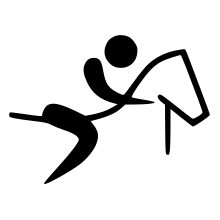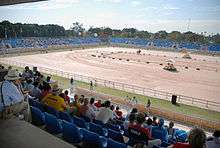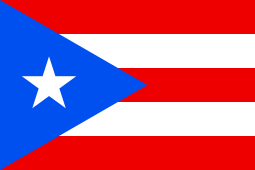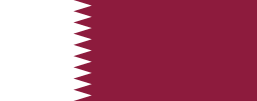Equestrian at the 2016 Summer Olympics
The equestrian events at the 2016 Summer Olympics in Rio de Janeiro were held between 6 and 19 August at National Equestrian Center in Deodoro. Medals were awarded in three disciplines for both individual and team competitions.
| Equestrian at the Games of the XXXI Olympiad | |
|---|---|
%2C_Rio_2016.png) %2C_Rio_2016.png) %2C_Rio_2016.png) Pictograms for Dressage (left), Jumping (center), and Eventing (right) | |
| Venue | National Equestrian Center |
| Dates | 6–19 August 2016 |
| No. of events | 6 |
| Competitors | 200 from 43 nations |
| Equestrian at the 2016 Summer Olympics | ||
|---|---|---|
 | ||
| Qualification | ||
| Dressage | individual | team |
| Eventing | individual | team |
| Jumping | individual | team |
Events

Medals were awarded in the following competitions:
Qualification
Each event had its own qualification rules, but generally rely on FEI rankings.
Dressage
For the team competition, ten quota spots were available. Three team spots were awarded at the 2014 FEI World Equestrian Games. In addition, six more were awarded at regional competitions (Europe: 3, America: 1, Africa/Asia: 2). In addition, should a country had qualified 3 or 4 athletes in the individual competition, they also qualified as a team and were allowed to compete in the team competition.[1]
For the individual competition, 60 spots were allocated as follows: 40 to the athletes who qualified from the teams above. In addition, the two highest ranked riders from each of seven geographic regions were qualified. The top six riders based on FEI ranking who did not qualify otherwise were given spots as well.[1]
Jumping
A country might have sent up to four riders if it had qualified for the team competition. Similar to dressage, teams of four riders were qualified at either the World Equestrian Games (WEG) or through a regional competition. The WEG awarded five spots, the regions nine (Americas: two, Europe: four, Asia: two, Africa and the Middle East: one), and the hosts (Brazil). For the individual competition, a total of 75 spots was allocated as follows: 60 from the above teams the rest regional or through rankings.[2]
Eventing
A country might have sent up to four riders if it had qualified for the team competition. Similar to dressage, teams of four riders were qualified at either the WEG, a regional competition, or through a composite spot. The WEG awarded six spots, the regions seven (America: one, Europe: two, Asia, Africa and Oceania: one), the hosts (Brazil). For the individual competition, a total of 65 spots was allocated as follows: 44 from the above teams, 7 through regional competitions and 14 through the world rankings.[3]
Participating
Participating nations
43 nations qualified. Chinese Taipei, Dominican Republic, Palestine, Qatar and Zimbabwe made their Olympic debuts in equestrian events.[4]



.svg.png)







































Officials
Appointment of officials is as follows:[5]
- Dressage







.svg.png)
- Jumping





- Eventing





.svg.png)
Competition format
Show jumping
Five rounds are ridden to determine individual medals. Riders placing first through 60th (including ties for 60th place) advance to the second round. The top 45 riders of round 2, including ties for 45th, advance to the third round. The top 35 riders of the third round progress to the 4th round, but only up to three riders per team (so if a country has four riders in the top 35, one of those is not allowed to compete for individual medals).
In the fourth round (individual final round A), the slate is wiped clean and all riders begin with zero faults. The top 20 riders in round 4 advance to round 5 (individual final round B), and ride another course. The faults for individual final round A and B and added together to determine individual medals.
The team competition completes three rounds to determine medals. It runs concurrently with the individual competition (riders running over the same course) so team riders are also competing for individual medals. The first round for team competition is the round 2 course for individual medals. The top eight teams from the first team round advance to the second team round (which is the same course as the individual round 3). The scores for these eight countries over team rounds 1 and 2 are combined, and medals are awarded based on those scores.[6]
Dressage
Teams are made of up to four riders, all of whom are also competing concurrently for individual medals. Additionally, countries who can not make a full team may send riders to compete for individual medals.
All riders compete in the Grand Prix, which serves as the first round of both the individual and team medals. The top six teams (included those tied for 6th) advance to the Grand Prix Special, which is a slightly more rigorous test. The combined scores of the top three riders of those teams in both the Grand Prix and the Special determine the team medals, with the team with the highest score winning gold.
Riders completing the Grand Prix test (first qualifying round of the individual competition) may move on to the Grand Prix Special (second qualifying round for the individual competition) if their team is in the top six (24 riders total). Additionally, the top 8 riders who do not qualify with a team may also advance to the Special to ride for individual medals. The top 18 riders from the Special move on to the third individual round, the freestyle. However, no more than three members on a team may advance. Each rider designs their own test for the freestyle, which must be set to music and has several compulsory movements. Riders can tailor a test to their horses' strengths, as well as incorporate movements that are more difficult than those required in the Grand Prix or the Special (such as a pirouette in piaffe) in order to increase their scores. As the slate is wiped clean after the first two rounds, individual medals are assigned based on scores in the freestyle.[7]
Eventing
Competitions for team and individual medals ran concurrently. Riders performed a dressage test, a cross-country round, and a jumping round. Team medals were then awarded by adding together the best three scores from a country's team, out of a maximum of five team members, from all three phases, the team with the lowest number of penalty points winning the gold. The top 25 individual scores after the first show jumping round performed a second, final, show jumping round to determine individual medals, with up to 3 riders in the individual running per team. Therefore, those competing for individual spots completed one dressage test and cross-country round, and two jumping rounds.[8]
Medal summary
The 2016 event was marked by returning champions in the individual events, and new nations winning the team events. 2012 Individual eventing champion Michael Jung retained his title, as did 2012 Individual dressage gold medallist, Great Britain's Charlotte Dujardin on Valegro. In jumping, veteran Nick Skelton, part of the gold medal winning Great Britain jumping team from 2012, returned to take the individual title on Big Star, his 2012 gold winning horse.
In the team events, Germany displaced Great Britain from the top step of the Team Dressage podium, with the 2012 winners in silver, and the United States taking an unexpected bronze ahead of traditional powerhouse, the Netherlands. In Eventing and Jumping, France won the team gold medals.
As a result, Germany, Great Britain and France dominated the medal table with two golds each, Germany leading by dint of four minor medals to the one silver each for France and Great Britain.
Medal table
| Rank | Nation | Gold | Silver | Bronze | Total |
|---|---|---|---|---|---|
| 1 | 2 | 2 | 2 | 6 | |
| 2 | 2 | 1 | 0 | 3 | |
| 2 | 1 | 0 | 3 | ||
| 4 | 0 | 1 | 2 | 3 | |
| 5 | 0 | 1 | 0 | 1 | |
| 6 | 0 | 0 | 1 | 1 | |
| 0 | 0 | 1 | 1 | ||
| Totals (7 nations) | 6 | 6 | 6 | 18 | |
Medalists
| Event | Gold | Silver | Bronze | |||
|---|---|---|---|---|---|---|
| Individual dressage |
on Valegro (GBR) |
on Weihegold Old (GER) |
on Desperados FRH (GER) | |||
| Team dressage |
Sönke Rothenberger on Cosmo Dorothee Schneider on Showtime FRH Kristina Bröring-Sprehe on Desperados FRH Isabell Werth on Weihegold Old |
Spencer Wilton on Super Nova II Fiona Bigwood on Orthilia Carl Hester on Nip Tuck Charlotte Dujardin on Valegro |
Allison Brock on Rosevelt Kasey Perry-Glass on Dublet Steffen Peters on Legolas Laura Graves on Verdades | |||
| Individual eventing |
on Sam FBW (GER) |
on Piaf de B'Neville (FRA) |
on Mighty Nice (USA) | |||
| Team eventing |
Karim Laghouag on Entebbe Thibaut Vallette on Qing du Briot Mathieu Lemoine on Bart L Astier Nicolas on Piaf de B'Neville |
Julia Krajewski on Samourai du Thot Sandra Auffarth on Opgun Louvo Ingrid Klimke on Hale-Bob Old Michael Jung on Sam FBW |
Shane Rose on CP Qualified Stuart Tinney on Pluto Mio Sam Griffiths on Paulank Brockagh Chris Burton on Santano II | |||
| Individual jumping |
on Big Star (GBR) |
on All In (SWE) |
on Fine Lady 5 (CAN) | |||
| Team jumping |
Philippe Rozier on Rahotep de Toscane Kevin Staut on Rêveur de Hurtebise Roger-Yves Bost on Sydney une Prince Pénélope Leprevost on Flora de Mariposa |
Kent Farrington on Voyeur Lucy Davis on Barron McLain Ward on Azur Elizabeth Madden on Cortes 'C' |
Christian Ahlmann on Taloubet Z Meredith Michaels-Beerbaum on Fibonacci Daniel Deusser on First Class Ludger Beerbaum on Casello | |||
References
- "Qualification System: Rio 2016 – Equestrian (Dressage)" (PDF). FEI. Archived from the original (PDF) on 10 September 2014. Retrieved 27 August 2014.
- "Qualification System: Rio 2016 – Equestrian (Jumping)" (PDF). FEI. Archived from the original (PDF) on 10 September 2014. Retrieved 5 September 2014.
- "Qualification System: Rio 2016 – Equestrian (Eventing)" (PDF). FEI. Archived from the original (PDF) on 10 September 2014. Retrieved 1 September 2014.
- "Six nations make Olympic and Paralympic débuts at Rio 2016 equestrian events". FEI. 24 March 2016. Retrieved 26 March 2016.
- https://data.fei.org/Calendar/ShowDetail.aspx?p=D27E1E3AE6653C86D3C95F40AEF01F97
- "Rio 2016: Equestrian Jumping". Rio 2016. Archived from the original on 21 August 2014. Retrieved 11 September 2014.
- "Rio 2016: Equestrian Dressage". Rio 2016. Archived from the original on 21 August 2014. Retrieved 11 September 2014.
- "Rio 2016: Equestrian Eventing". Rio 2016. Archived from the original on 15 September 2014. Retrieved 11 September 2014.
External links
| Wikimedia Commons has media related to Equestrian sports at the 2016 Summer Olympics. |
- "Equestrian at the 2016 Summer Olympics (Rio2016.com)". Archived from the original on 26 August 2016. Retrieved 23 July 2018.CS1 maint: BOT: original-url status unknown (link)
- Equestrianism at the 2016 Summer Olympics at SR/Olympics
- Results Book – Equestrian